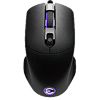 3
3
EVGA X12 Gaming Mouse Review
(3 Comments) »Introduction

Founded in 1999, EVGA is a US-based computer hardware company. Much like other recent EVGA mouse releases, the X12 comes with a whole host of features. First of all, just like the X15 and X17, the X12 is capable of true 8000 Hz polling. PixArt's PMW3389 sensor is used, complemented by an additional lift-off distance sensor, which allows even finer LOD adjustment. In addition to that, the X12 isn't just ambidextrous but symmetrical, which means it has side buttons on both sides. Omron switches rated for 60 million clicks are used for the main buttons. Furthermore, the X12 is compatible with NVIDIA Reflex, allowing one to measure click latency in real time on a Reflex-enabled monitor. Rich RGB lighting is present as well, and can be configured through EVGA Unleash. Despite all these features, the X12 weighs no more than 74 g, and additionally retails for just $49.99.

Specifications
| EVGA X12 | |
|---|---|
| Size: | 123 mm x 70 mm x 41 mm |
| Size (inches): | 4.84" x 2.76" x 1.61" |
| Ambidextrous: | Yes (side buttons on both sides) |
| Weight: | 74 g |
| Number of Buttons: | 8 (including wheel click) |
| Main Switches: | Omron D2FC-F-K (60 M) (China) |
| Wheel Encoder: | Mechanical |
| Sensor: | PixArt PMW3389 |
| Resolution: | 50–16,000 CPI |
| Polling Rate: | 125/250/500/1000/2000/4000/8000 Hz |
| Cable: | 2 m, braided |
| Software: | Yes |
| Price: | $49.99 |
| Warranty: | Three years |
Packaging
Aside from the mouse, one finds a quick-start guide in the box.
Weight
My scale shows around 74 g (+/- 1 g), which is largely in line with the weight EVGA cites. Considering its medium size, lack of holes, and the presence of features such as side buttons on the right side and an additional LOD sensor, the weight is more than reasonable.
Our Patreon Silver Supporters can read articles in single-page format.
Apr 19th, 2025 06:26 EDT
change timezone
Latest GPU Drivers
New Forum Posts
- 5070ti overclock...what are your settings? (12)
- Which 5080 graphics card? (11)
- RX 9000 series GPU Owners Club (401)
- TPU's Nostalgic Hardware Club (20259)
- Looking for a rolling workbench recommendation (11)
- NVIDIA GeForce 576.02 WHQL driver (6)
- [Test Build] Fix for 576.02 Driver Install (7)
- need help with 12900hx (0)
- PC Audio Speakers Amp/DAC/Receiver/other options? (7)
- Undervolt/TPL on i7-10700k (0)
Popular Reviews
- ASUS GeForce RTX 5060 Ti TUF OC 16 GB Review
- NVIDIA GeForce RTX 5060 Ti PCI-Express x8 Scaling
- ASRock X870E Taichi Lite Review
- Palit GeForce RTX 5060 Ti Infinity 3 16 GB Review
- Teevolution Terra Pro Review
- ASUS GeForce RTX 5060 Ti Prime OC 16 GB Review
- MSI GeForce RTX 5060 Ti Gaming OC 16 GB Review
- Zotac GeForce RTX 5060 Ti AMP 16 GB Review
- MSI GeForce RTX 5060 Ti Gaming Trio OC 16 GB Review
- G.SKILL Trident Z5 NEO RGB DDR5-6000 32 GB CL26 Review - AMD EXPO
Controversial News Posts
- NVIDIA GeForce RTX 5060 Ti 16 GB SKU Likely Launching at $499, According to Supply Chain Leak (182)
- NVIDIA Sends MSRP Numbers to Partners: GeForce RTX 5060 Ti 8 GB at $379, RTX 5060 Ti 16 GB at $429 (127)
- Nintendo Confirms That Switch 2 Joy-Cons Will Not Utilize Hall Effect Stick Technology (105)
- NVIDIA Launches GeForce RTX 5060 Series, Beginning with RTX 5060 Ti This Week (103)
- Over 200,000 Sold Radeon RX 9070 and RX 9070 XT GPUs? AMD Says No Number was Given (100)
- Nintendo Switch 2 Launches June 5 at $449.99 with New Hardware and Games (99)
- Sony Increases the PS5 Pricing in EMEA and ANZ by Around 25 Percent (85)
- NVIDIA PhysX and Flow Made Fully Open-Source (77)

